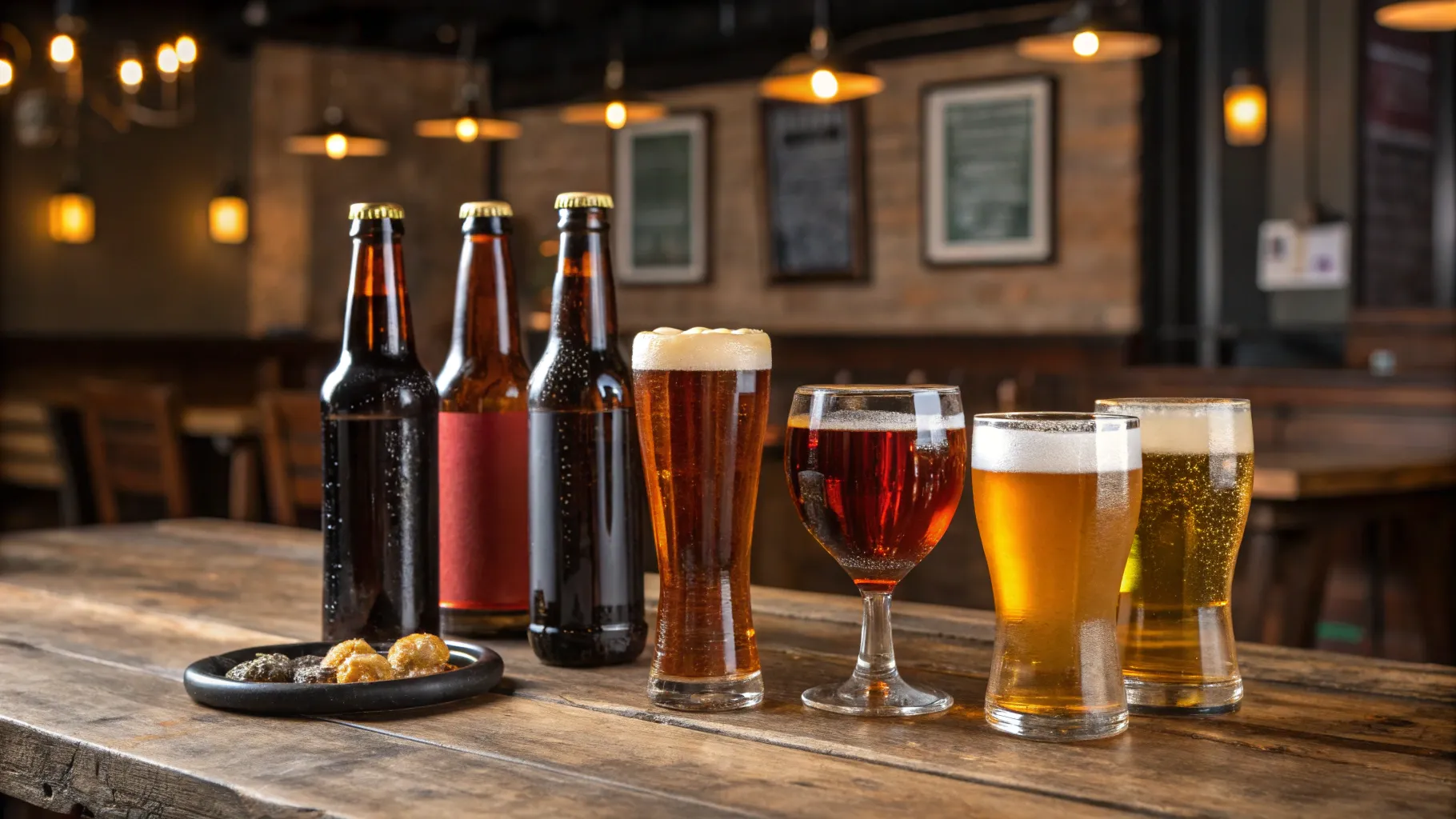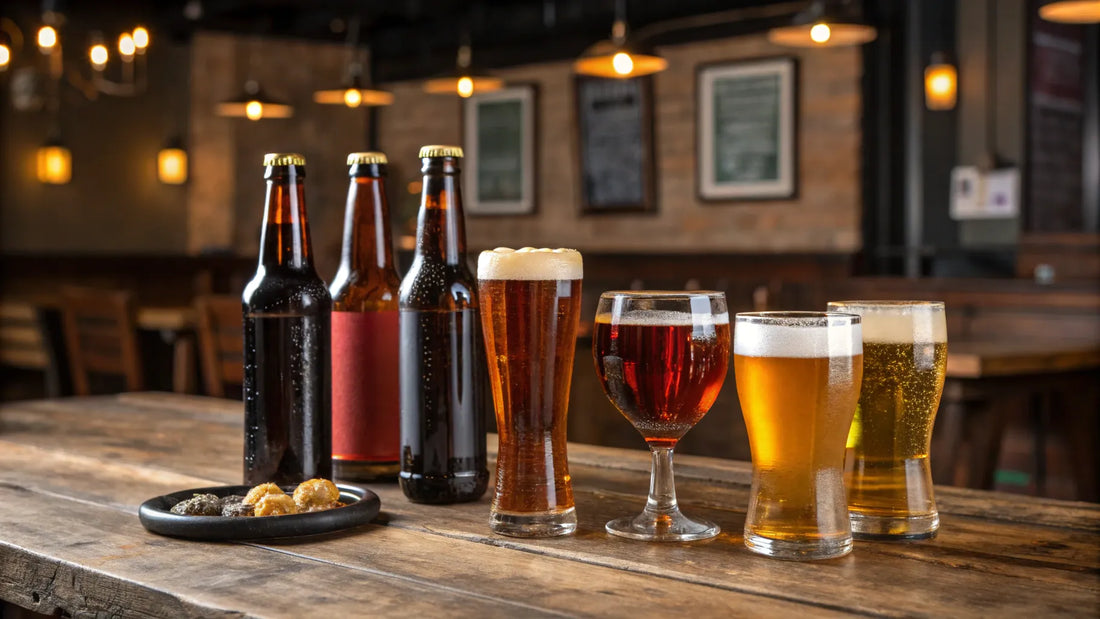Why some beers are objectively better than others

In this blog, we dive into the world of beer and explore why the term 'balance' is actually not that useful. We discover how a clear structure in beer can make a difference, making some beers objectively better than others. Let's embark on this fascinating journey through different types of beer together.
Introduction 🍻
Welcome to the world of beer, where we explore the deeper layers of flavor and structure. Understanding beer goes beyond just the basic components; it is a journey through the diverse styles and their unique characteristics. In this section, we will examine the fundamentals of what balance means in the context of beer and why it can be a misunderstood concept.
What does balance mean? ⚖️
Balance in beer is a term that is often used, but what does it actually mean? Balance is often seen as a harmonious combination of sweetness, bitterness, and other flavors. However, in the world of craft beer, balance is not always the holy grail. Strong beers like the New England IPA are anything but balanced, yet they can still provide a great drinking experience.
When evaluating beer, it is important to understand that balance does not always have to be an end goal. Sometimes it is the unbalanced elements that make a beer interesting and unique. This leads us to the question: what makes a beer truly good?
Balanced styles 🍺
"There are certainly beer styles that focus on balance. Take, for example, the British bitter, which is known for its harmonious combination of malt and hop character. The different flavors come together to form a complete and satisfying whole. But even within these styles, personal preference can influence the perception of balance."
- British Bitter: A perfect harmony of caramel, bread, and fruity hop aromas.
- Helles: A malty base with a subtle bitterness.
- Stout: Rich flavors of chocolate and coffee, with a complex structure.
"It is crucial to recognize that what feels balanced for one drinker may not feel that way for another. This brings us to the next step in our exploration: the structure of beer."
Structure in beer 🏗️
Structure in beer refers to the way flavors develop and complement each other while drinking. It's like a story: there is a beginning, a middle, and an end. A well-structured beer takes you on a journey, with each sip revealing something different.
Take a stout, for example. The first sip can be sweet and creamy, but as you continue to drink, the roasted notes come forward, giving you a complex palette of flavors. This is the magic of structure; it creates a dynamic experience that keeps the drinker engaged.
Different types of beer 🍻
The world of beer is incredibly diverse, with countless styles, each having its own unique characteristics. Here are some of the most notable styles that we can explore:
- New England IPA: A fruity, hoppy experience that is often considered unbalanced, but offers a strong structure.
- Stout: Dark beers that are rich in flavors like chocolate and coffee, with a complex mouthfeel.
- Quick Sour: A fresh, sour style that is quickly fermented, with unique flavors that stimulate the senses.
- Pilsner: Often seen as simple, but with a subtle complexity that makes it a popular choice.
"Every style has its own story and character, and it is that character that appeals to us as drinkers. By understanding this diversity, we can better appreciate what makes a good beer."
The New England IPA: an unbalanced hero 🍍
"When we talk about the New England IPA, we are discussing a style that is often considered unbalanced, yet has a tremendous appeal. These beers are famous for their fruity aromas and full mouthfeel, but they are not meant to provide a harmonious balance. Instead, it’s all about the hops, which take center stage."
The New England IPA is an explosion of flavors, with notes of tropical fruit such as mango, pineapple, and citrus. This comes from an abundant hop addition during the brewing process, giving these beers a unique and powerful character. The challenge lies in creating structure, especially since many of these beers have a bland aftertaste without the right bitterness.
A good example is the Beak IPA, which not only emphasizes the fruity hop aromas but also adds a pleasant bitterness. This bitterness ensures that the experience does not end abruptly but offers a nicely rounded finish. This is what makes the New England IPA so special: even though it is unbalanced, the structure makes it a pleasure to drink.
The allure of bitterness 🍊
Bitterness in beer is often a topic of discussion. Many people tend to avoid bitter beers, but there is something intrinsically appealing about those sharp flavors. Bitterness is not just a matter of taste; it also has a psychological and physiological impact on our body.
Our taste buds have evolved to detect bitterness and associate it with potential danger. When we taste something bitter that is not harmful, we experience an adrenaline boost. This creates a sense of excitement and adventure, similar to the experience of a roller coaster ride. It is this thrill that can consume us and make us crave more.
In the context of beers like the New England IPA, the addition of bitterness can enhance the overall drinking experience. It provides a dynamic finish that brings out the different layers of flavors in the beer. Bitterness can thus be an addictive element that encourages us to take another sip.
De Stout: a classic with character 🍫
Stout is one of the most beloved beer styles in the world. These dark beers are rich in flavors, with notes of chocolate, coffee, and roasted grains. It is the complexity and depth of the flavors that give stout a unique character.
When tasting a stout, we can perceive various aromas, from sweet caramel to savory notes of roasted coffee. The texture of a stout is also something to appreciate; it often starts sweet and creamy, but develops into a robust, smoky finish.
What makes the stout truly special is the variety of grains used. By combining different types of malt, brewers can create a complex palette of flavors. This allows for a journey through the tastes, where each sip reveals something new.
Quick sour beers: the controversial choice 🍋
Quick sour beers, such as Gose, are often the subject of controversy in the beer world. Some consider them too simple, while others appreciate the unique flavors and structures they offer. These beers are often soured through accelerated fermentation with lactic acid bacteria, resulting in a refreshing acidity.
The appeal of sour beers lies in their ability to provide a refreshing experience. The acidity can be an exciting complement to the flavors of fruit and spices, resulting in a beer that is both thirst-quenching and challenging. The use of ingredients like salt in a Gose can further enhance the drinking experience, creating an interesting combination of flavors.
"Although quick sour beers may not be for everyone, it is their unique character that sets them apart from other styles. It is an adventure for the taste buds that is definitely worth exploring."
Pilsner: the most popular yet often misunderstood style 🍺
Pilsners are the most consumed beer style worldwide, but they are often misunderstood. Many people consider pilsners to be simple, but they have their own unique complexity. A good pilsner has a balanced combination of malt and hops, resulting in a refreshing and drinkable experience.
Take, for example, the Heron Pilsner from Kiesman. This beer has a delicate balance of flavors that combine the typical sweetness of malt with a pleasant bitterness. The aroma is a mix of honey and citrus, leading to an interesting taste experience that goes beyond the superficial characteristics of many commercial pilsners.
The complexity of pilsners arises from the ingredients used and the brewing process. A well-brewed pilsner not only has a refreshing taste but also offers a journey through various flavors and aromas. It is this depth that makes pilsners so accessible to a wide audience, while still appealing to the connoisseurs among us.
Macro Pilsners: a growing segment 🍺
The world of macro pilsners is growing rapidly, and not without reason. These beers are often accessible, with a flavor profile that appeals to a wide audience. Macro pilsners like Heineken and Budweiser are ubiquitous, but there is a new wave of craft macro pilsners that is starting to conquer the market.
What distinguishes this new generation of pilsners is their focus on quality and flavor. Breweries are experimenting with different hop varieties and malts to create unique tastes, while still maintaining the essence of a pilsner. This has led to a renewed interest in what was once considered a simple beer style.
Macro pilsners offer a refreshing and thirst-quenching experience, perfect for social occasions and summer days. The appeal lies in their accessibility and the ability to consume them in large quantities without being overwhelmed by complex flavors. But is that enough to distinguish them in a world full of craft beers?
What does all this mean? 🤔
The growing segment of macro lagers raises questions about what we value in beer. While some people prefer complex, craft beers, others are satisfied with the simplicity and drinkability of macro lagers. This leads to a discussion about the value of structure versus balance in beer.
Structure in beer refers to the way flavors develop and complement each other. It is the journey you take with each sip, and it can be just as present in a macro pilsner as in a craft beer. It is important to recognize that not all beers need to be balanced to be appealing.
"The challenge for breweries is to create the right structure that enhances the drinking experience. Macro pilsners often provide a clean, refreshing finish that quenches thirst, but sometimes lack the complexity that craft beers offer. This brings us to the role of structure in beers."
The role of structure in beers 🏗️
Structure in beer is crucial for the overall drinking experience. It refers to how the flavors develop from the first sip to the aftertaste. A well-structured beer has different layers of flavors that offer the drinker a journey through the various aromas and tastes.
For example, in a well-brewed stout, the structure can start with sweet caramel tones, followed by the savory flavors of roasted grains, and end with a bitter aftertaste. This layering keeps the drinker engaged and ensures that each sip feels different.
Macro pilsners also have their own structure, although it is often simpler. The sparkle and refreshment of a good pilsner can make the experience dynamic, even if the flavors are less complex. It is this structure that ensures that macro pilsners remain popular, even in a world that is increasingly focused on craft beers.
Your opinion on beer structure 💭
"Now that we have discussed the various aspects of beer structure, it's time to hear your opinion. What is your view on the structure of beer? Do you think it is more important than balance, or do you consider both essential for a good drinking experience?"
The discussion about beer structure versus balance is a fascinating topic that occupies many beer enthusiasts. While some prefer the complexity of craft beers, others are satisfied with the simplicity and accessibility of macro lagers. It is this diversity of flavors and preferences that makes the world of beer so captivating.
Let us know what you think! Share your experiences with different beer styles and how they appeal to you. Whether you are a passionate lover of craft beers or enjoy a refreshing macro pilsner, your opinion is valuable in this discussion. Cheers! 🍻





